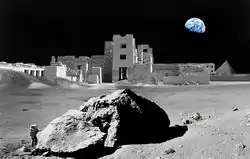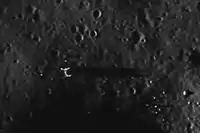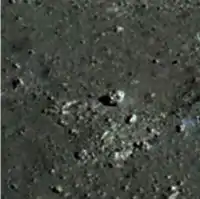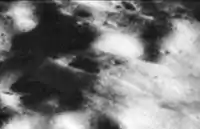Lunar anomalies
Just as with the loonies who're constantly combing all images from the planet Mars for anomalies "that NASA has tried to cover up," so many of the same people use low-resolution, 40-year-old images of the Moon to make the same daft accusations. They show little to no interest in the enormous library of high-definition imagery still pouring in from Lunar Reconnaissance Orbiter. LRO's Wide Angle Camera has now covered the entire Moon at 77m resolution, and the Narrow Angle Cameras have returned images of more than 50% of it at an incredible 0.8m. These images are mostly ignored by the loonies because they are too good and don't leave any room for doubt.[note 1]

| Some dare call it Conspiracy |
| What THEY don't want you to know! |
| Sheeple wakers |
v - t - e |
The chief online gathering place and meta-group for these strange persons is the United Family of Anomaly Hunters (UFAH)
The loonies
The cast of characters who populate this virtual burlesque show is not very diverse. In the main, they are people with no actual expertise in any related subject, such as geology, palaeontology, or image processing and interpretation. They tend to have had just enough contact with science to be able to write stuff that simulates scientific text.
Mike Bara
Mike Bara, who was for many years in the shadow of his former co-author Richard Hoagland, must now be given the accolade of Chief Lunar Anomaly Loony, since in 2012 he wrote Ancient Aliens on the Moon. Mike was also the curator of the website www.lunaranomalies.com until it was hacked by Japanese porn merchants. The Lunaranomalies blog was last updated 11 August 2009.
Interviewed on the Freedom of Perception internet radio show in May 2016, Bara said he was convinced there were artifacts of a lunar civilization littering the Moon. They were not just rocks, he said, because "rocks have very specific shapes."
Bara's knowledge of geology is very close to zero. As for his knowledge of photo interpretation, one need look no further for his ignorance than this passage describing images of Earth from space.
| "[T]he clouds are the highest in the atmosphere, meaning that they are reflecting more light back to the camera and at a faster rate. Since they are returning more light, the clouds are the lightest. The surface areas … are darker, because they are a bit further away from the camera than the clouds and therefore the light has to travel further before it is reflected back. The deep blue oceans are therefore the darkest, because the light has to travel all the way to the ocean floor before it is reflected back to the camera." — Ancient Aliens on the Moon, p.125 |
One likes to think that if his publisher, Adventures Unlimited Press, had known he was quite that devoid of accurate knowledge they wouldn't have contracted him to write a book whose main theme is image interpretation. But you never know.
Richard C. Hoagland
Richard Hoagland, a former museum curator who hasn't had a job since 1983, has expended an amazing amount of effort concocting ridiculous fantasies about rocks and mesas on both Mars and the Moon (oh, and Phobos, and Vesta, and pretty much anything that NASA/JPL releases pictures of[note 2].)
Jose Escamilla
The late Jose Escamilla was an ignorant and bad-tempered jerk who made silly videos. The vids have only one virtue — excellent incidental music. Their content is garbage. The two that have to do with Lunar anomalies are:
Escamilla, notwithstanding his lack of any training in selenology, believed he knew better than NASA what color the Moon is. According to his videos, most of the craters on the Moon are actually flying saucers. There's a statue of a human figure more than six miles high near Aristarchus (23.7°N 47.4°W). Not only have all the post-postdoctoral researchers at Arizona State University photoshopped this Ozymandias out of existence; but thousands of astronomers both professional and amateur who would have quite easily seen it, if it existed, have all phoned each other up and said "Look, chaps, let's just pretend we saw it, eh, to be nice to Jose". The effect on angles of light directly from the Sun, or incidentally from the Earth, and the shadows/colors emitted accordingly, are way beyond the scope of mental ability used towards any of the film's or writings of Jose Escamilla.
Keith Laney
Keith Laney is the exception to the general rule that the loonies have no clue. Laney does have genuine expertise in image processing, and has even done some commendable work enhancing JPL images. He hosts the Hidden Mission Web Forum, which is frequented mainly by rednecks who don't believe anything that comes out of NASA, JPL, Arizona State University (whose School of Earth and Space Exploration does the data processing for LRO), and most particularly Malin Space Science Systems and its head Michael Malin. Malin enrages the HMF crowd because his company designs most of the cameras used by JPL and it's believed that he gets first dibs on tampering with all the images as he pleases.
Laney concocted an elaborate fairy tale about the Apollo 17 mission, which he called A Hidden Mission for Apollo 17. This text was stolen by inspired Mike Bara to write a similar yarn in his silly book.
Keith Laney may be expert at image editing but he knows so little about space mission management that he actually believes spacecraft controllers deliberately cause failures of their own missions (we're not making that up, folks.) In July 2015, after the Dawn and New Horizons missions both suffered computer glitches that were rapidly resolved, Laney wrote:
“”Looks to me like both Dawn and New Horizon teams have been given a warning. I'm so sick of these clods stifling what we get to see and know… they would rather cause the crafts to malfunction and fail than allow us to know what they're really seeing. |
George Haas
George Haas is a sculptor who calls himself The Cydonia Institute. George might more accurately have called his fake organization The Pareidolia Institute. He spends his days looking over JPL images and every so often declares that he's discovered a parrot, a road-runner, a howler monkey, a helmet, or a little devil-face. Sometimes his menagerie only looks like half an animal, in which case he mirrors it in Photoshop and points out how symmetrical it is. George deals mainly in Martian animals, but he creates travesties with lunar images sometimes, too.
George's web site is a total disgrace. Whoever designed it hadn't heard of the brilliant new idea known as text width.
Bret Colin Sheppard
Bret Sheppard is an artist who became intrigued by this topic after seeing an image used in Ingo Swann's remote viewing project at Stanford Research Institute. He created the Lunar Anomaly Research Society and devoted very considerable time to scouring Apollo imagery.
In 2016 Sheppard came across Ken Johnston and his collection of Apollo photo-prints. Since these prints are claimed to show "anomalies" that can not be seen in the NASA online collection, they were of great interest.[note 3] Sheppard and his partner Karen Patrick moved to Belen, NM to be near Johnston and took on the task of editing and publishing Johnston's autobiography Ken's Moon.[1] Sheppard devised and produced a press release which included many of the standard "anomaly" images, whose points of interest are mostly the results of scanner contamination.
Since Sheppard can not tell the difference between a satellite dish on the Moon and an S-Band antenna erected by Apollo astronauts,[2] his expertise is not much valued by space historians.
David Icke
David Icke is another lunatic (see what we did there?) who believes he is the Son of God and the Earth is ruled by lizards. He devotes his energies to giving talks about reptilians, alien hybrids, Doomsday, spotting moon anomalies (moon polar flip to name one). He is also a part-time prophet. Crank magnetism at its best.
UFO Digest
The e-zine UFO Digest and its editor, Robert Morningstar, have been responsible for a fair bit of lunar anomaly woo over the years. On 29 May 2007 the digest published a credulous article written by Luca Scantamburlo and edited by Morningstar swallowing the Apollo 20 crashed spaceship hoax[3]
On 1 January 2010, in an article titled The Sentinel, it was an Apollo 10 image[4] showing a piece of detached mylar insulation that was the topic of Morningstar's misinformation. Lecturing at the Secret Space Program conference in June 2014, Morningstar declared that this object was in fact a space station, and estimated that its major dimension was 166 miles.[5]
On 7 November 2006, Morningstar published in UFO Digest[6] an article titled "Treasure of the Abyss: Morningstar Discovers Luminous 'Sky Object' Above Lunar Surface In Apollo 16 Photograph".
The 'Sky Object' he cited is a scanning blemish in the Hasselblad frame AS16-109-17761[7]. The image was shot by LMP Charlie Duke from the Lunar Roving Vehicle (LRV) on the way to Station 1, EVA-1. The blemish is just above the horizon, about two-thirds from the left edge, near the 4th fiducial from left. It does not appear in the Lunar & Planetary Institute version of the image[8], which would have been scanned at a different time.
Morningstar wrote When one studies the photo with a 'photographer's eye,' one can see that in the composition of the photo, the 'Sky Object' appears to be the focal point of the astronaut-photographer's attention nearly in the center of the frame.. That statement is untrue. The LRV was moving, over terrain that was not smooth, in lunar gravity. Under the circumstances it is not credible that Duke could have targeted such a small object — and indeed, it is not in the center of the frame. Oh, and one more thing — it isn't an object at all.
The "anomalies"
The Zond 3 "dome"
It was 1965. Space technology was in its infancy. The Soviets did extremely well to get images of any kind from a lunar fly-by. Zond 3 came within 9,200 km and returned 23 images. This one excited the loonies because, down at the lower right corner, a photo-stitching error made it appear that some kind of dome was projecting from the surface.
They don't seem at all interested in this LROC frame of the area, proving that there is no dome. Off to the right is the Mare Humorum — the Sea of Humors. I don't think it's poking fun at the lunar anomalists, but I could be wrong.
The tower and the shard
Richard Hoagland spotted these babies in frame M-84 from Lunar Orbiter 3 (launched February 1967). The dominant crater is Bruce, at 1.1°N 0.4°E, quite close to slap-bang in the middle.
Lunar Orbiter used a wet film development process, and there are splatters all over its imagery as a consequence (fluids + zero-g = random messes). Hoagland zoomed in on a couple of them and declared them to be artificial. Amazingly, there are people who believe him even today.
The castle

This one is a detail from Apollo 10 lunar orbital photography in black and white--Frame AS10-32-4822. The crater is Manilius, named for Roman astronomer Marcus Manilius, and its coordinates are 14.5°N, 9.1°E.
Hoagland sees this splodge and calls it "The Castle." It would be about six miles tall if it existed, suspended seven miles above the surface. In some versions of the image, Hoagland says he sees a cable holding this thing up. There's a secret to getting blabbermouth Hoagland to stop talking. It's this — ask him what the top ends of the cable are attached to.
The paperclip
One version of that same Apollo 10 image includes a curly fiber that whoever scanned it didn't notice. The loonies declare that it's obviously an antenna of some kind. It would be about 3 km long if it were real. The Emoluments of Mars blog covered this well.
The spar
An Italian web site, years ago, published a version of the Apollo 17 Hasselblad frame AS17-136-20767 which had a scanning fault stretching across East Massif. Although this fault, obviously, is not in the original frame, Hoagland and Bara contend that the Italian scan is the more authentic version, and that this is a support strut that originally held up the vast glass domes over the Apollo 17 site. NASA, of course, has airbrushed it out. Bara wrote "this obviously structural spar…"
The Italian enthusiast who actually performed that scan, Davide De Martin, would not agree. He says it's a fiber. Frame 20767 is part of a panoramic photo-set, and the frames either side, 20766 and 20768, overlap enough that they would show the "spar" if it was there. De Martin wrote:
“”That's not a spar, obviously, but just an artifact likely due to the scanning process or whatever. No trace of the artifact in 20766 and 20768 which show the same hill. |
The satellite dishes
No single image better illustrates the loonies' technique of deliberately choosing low-res images than this one. It's a wide-angle shot taken from lunar orbit by Apollo 16, showing fully a third of the Moon. A little below center is the crater Asada, at the edge of the Sea of Fertility (7.3°N, 49.9°E). Asada is 12 km across, and occupies 78 pixels of the image. So the resolution works out to 154 metres/pixel.
Mike Bara contends that Asada, and another crater, Proclus (13.4°N 42.3°E) are both satellite dishes. Er... make that extremely large satellite dishes. Both these craters have been imaged by LRO's narrow-angle camera. The images are here and here.[note 4] When he was being interviewed on Coast to Coast AM, a caller asked Mike why he didn't show images that are about 300 times better resolution, to determine if these really are satellite dishes. Mike replied that the Sun angle on the LROC images is too high to really see the details. He wasn't challenged by host George Noory, and the caller was not allowed to press the point.
Another problem for Bara's loony idea is that a selenostationary orbit is not possible, since it would bring a satellite beyond the L1 libration point.[note 5] So it's quite hard to see what use a satellite dish would be.
The robot head

Art Bell, George Noory (both of Coast to Coast AM) and Kerry Cassidy all lapped this one up like a cat with a bowl of cream. It's a rock in the crater called Shorty, which was Station 4 of EVA2, Apollo 17 (the final moon mission). The rock has a superficial resemblance to a skull, and is sized appropriately.
Commander Gene Cernan took several shots of Shorty, which show the rock. This one is typical. Unless you know exactly where to look, you wouldn't find it, which gives the lie to Richard Hoagland's claim that the astronauts "could have" descended into the crater, retrieved it, and secretly brought it back for reverse engineering.[note 6] It's quite obvious that they couldn't possibly have seen it in the first place, let alone have got permission to undertake a potentially dangerous unplanned descent.
Hoagland produced this travesty for publication in the book Dark Mission. He actually superimposed several of Cernan's shots to, as he put it, "drive down the noise." This is a process that astronomers call "stacking" and it has legitimate use in astronomy. However, there is no justification for using it on well-focused, well-exposed, 70mm reversal film which has negligible noise as it stands. He also said he "color-corrected" the image. Unless you truly believe the Moon is green when photographed in close-up you would have to agree that "concocted" would be a more appropriate participle.
Compounding the general hilarity over this nonsense, Mike Bara came up with a Youtube demo showing how the "color correction" was done. His intention was to show how legitimate the process was — he says "This is nothing more than increasing … the volume of the color just the way you'd increase the volume of the audio on your TV set." In fact, he achieved exactly the opposite. He showed us exactly how dishonest the process was, by:
- White balancing on a part of the image that was not white
- Turning color saturation all the way to maximum
Even then, he admits he can't achieve the "anodized" appearance of Hoagland's fraudulent version and doesn't know how it was done.
The ziggurat

The notorious 1-mile square ziggurat on the far side of the Moon was first concocted by two jokesters, Frank Gault and Terry James (a.k.a. kksamurai) in May 1999. Frank's father was ex-NASA, and bequeathed a collection of 10x8 glossies of the Apollo archive. Using an Apollo 11 shot, at 174.34°E, 8.97°S — almost exactly opposite Earth — they created the ziggy. It got handed on from woo-site to woo-site over the years—here it is on holloworbs.com.
Naturally, the LROC image shows there's nothing there (it would be dead center in that frame). As he was writing Ancient Aliens on the Moon, Mike Bara came across kksamurai's image on the Call of Duty Zombies web site. Although at the time he didn't know the provenance of the image, he declared it to be the only authentic version and published it. Richard Hoagland used the anniversary of the Apollo 11 Moon landing in 2012 to proclaim, on Coast to Coast AM, that this was a genuine find that NASA had covered up.[note 7] He said he had "spent several days" authenticating the image, and one can only wonder WTF would take several days, especially since he came to exactly the wrong conclusion.
The mockery filled certain parts of the internet for a while. This deconstruction is the most thorough.
The Apollo 20 crashed alien spaceship

Somebody, possibly "William Rutledge" (Youtube ID retiredafb) noticed this 10km long feature on the far side of the Moon back in 2007. The image is a detail from a strip taken by the Apollo 15 pan camera. The photo ID is AS15-P-9625.[9] Coordinates are 117.68°E, 18.66°S, and the nearest named craters are Diderot and Delporte.
Once again, the anomalists rely on outdated, relatively low-resolution images to make their case. The high-res frame taken by the narrow angle camera of Lunar Reconnaissance Orbiter[10] shows that it's just a depression feature, cratered to the same density as the surrounding area.
"William Rutledge" was one of the alleged astronauts on the Apollo 20 hoax mission.[11]
The giant alien casting a long shadow
This one did the rounds in the summer of 2014, sparked by Youtube account holder wowforreel, and given added publicity by HuffPo, among other irresponsible media outlets.
A casual glance showed that the "shadow" was going in the wrong direction, and that this had to be one HUGE alien. It was left to Metabunk.org, in particular member Trailblazer, to conduct an exemplary investigation and show without doubt[12][13] that this was debris on the glass plate of the Apollo 15 mapping camera.
A real anomaly
The Compton–Belkovich Thorium Anomaly
Bibliography
- Hoagland, Richard C.; Bara, Mike (2007). Dark Mission: The Secret History of NASA. Port Townsend: Feral House. ISBN 978-1-932-59526-0.
- Bara, Mike (2012). Ancient Aliens on the Moon. Kempton, IL: Adventures Unlimited. ISBN 978-1-935487-85-2.
See also
- Mars Anomaly Research
- The Brookings Report, inaccurately cited as the reason why NASA airbrushes out ET
- Ken Johnston
Notes
- Or simply because, you know, NASA has edited them to remove said anomalies. Never mind that they're using as evidence images taken by said space agency. In February 2018, Robert Morningstar wrote on Facebook "[The] LROC image Library is a "Crook & a CrocK"... I will prove it on an upcoming show using Soviet Luna photos to expose your fraud and prove it. to the world. The LROC Image Library is a sham, pictures f a plaster model! LROC Images are a farce of science. It's all pure public deception. I'm going to call for a Federal investigation to expose NASA's embezzlement of billions of dollars in satelitte technology, software imaging and the archiving of the worst Disinformation Psy-Op that I've uncovered since the JFK Assassination cover-up.
- Not just NASA, but the European Space Agency as well. Appearing on The Caravan to Midnight internet radio in September 2014, Hoagland said that Comet 67P, with which the ESA spacecraft Rosetta rendezvoused in August, was clearly not a comet at all but an "ancient space station."
- Interviewed on Spaced Out Radio, 29 March 2017, Sheppard admitted that many of Johnston's 25-year-old prints were damaged but insisted that they were uniquely valuable.
- Note that Mike Bara actually misidentified this crater. It's not Proclus itself but the satellite crater Proclus A. Not to mention that Proclus
File:Wikipedia's W.svg itself is a quite conspicuous and large one. - This is true for any tidally-locked moon. A mathematical proof is here.
- Another fatal problem with that idea is that they had no means of picking it up. The tongs were sized for fist-sized rocks at most.
- If you're thinking that the Apollo 11 anniversary was not a moment to attack NASA on completely fictitious grounds, that shows how little you understand of the vindictive mind of Hoagland.
References
- Johnston, Dr. Ralph Kennedy Sr (2016). Ken's Moon: The Smoking Gun that Reveals the Dark Secret of NASA. CreateSpace Amazon self-publishing. ISBN 978-1535205962.
- Bret Sheppard, the satellite dish on the Moon, and the meaning of "acquisition" --The Emoluments of Mars blog, 30 March 2017
- AN ANCIENT ALIEN SPACECRAFT ON THE BACKSIDE OF THE MOON.
- AS10-28-3988.jpg in NASA image library
- The Emoluments of Mars blog took issue with Morningstar's calculation. Knowing the focal length of the camera lens and the dimensions of the film frame, it can be calculated that the "space station" would need to be 2,338 miles away if it really were 166 miles wide
- "Treasure of the Abyss" UFO Digest 7 November 2006
- AS16-109-17761 in the NASA photo library
- AS16-109-17761 in the Lunar & Planetary Institute library
- AS15-P-9625 in the Lunar & Planetary Institute library
- Permalink to the LROC NAC strip of the dune feature
- The Apollo 20 alien spaceship hoax Galaxiki Community Blog, 18 December 2007. Retrieved 8 April 2014
- Solved: "Alien" with "shadow" on the Moon (Debris in Camera) Metabunk 13 August 2014
- See the gallery of A15 mapping camera images. The "alien" is in the same position in every frame, visible by zooming in.